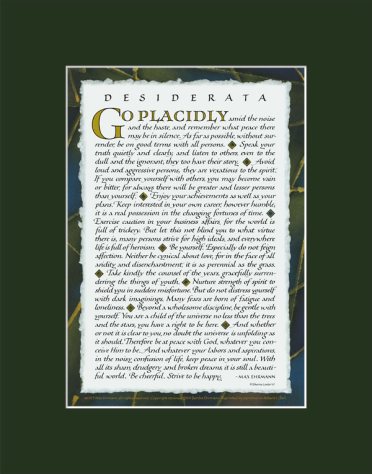Max Ehrmann
Max Ehrmann (1872-1945) was a scholar and poet, born in Terre Haute, Indiana on September 26, 1872. He was the youngest of five children of German immigrants. He graduated from DePauw University in Greencastle, Indiana in 1894, and then studied law and philosophy at Harvard University.
After being a lawyer for several years, Ehrmann went to work in his family’s business. After 10 years in the business world, Ehrmann retired so he could devote all his time to literary work. Toward the end of his life, during an interview, he told a writer, “At DePauw, I contracted a disease which I have never shaken off. The disease was Idealism. I took it to Harvard with me where I studied philosophy. Because of it I did the thing in life I wanted to do—writing.” 1
During his life, Max Ehrmann contributed great thoughts to our literary lexicons, blending the magic of words and wisdom with his worthy observations. 1
His deep and abiding concern over social issues are reflected throughout his many works. Such poems as Complacent Women, written in 1918, and Washington, D.C., written in 1924 about the oil scandals, are as relevant today as they were then. He searched endlessly for spiritual contentment, often turning to nature as in his poem, The Noise of the City and Away. His philosophical writings are a search for social truth and peace—messages that never age. 1
Max Ehrmann wrote many poems, although none were well known until after his death. They have been collected into several books including the Desiderata of Happiness, and the Desiderata of Faith. His two most famous poems are Desiderata (1927) and A Prayer (1906). He died on September 9, 1945, leaving his widow, Bertha K. Ehrmann, who wrote his biography in 1951.
Terre Haute celebrates Max Ehrmann
On August 26, 2010, 138 years after his birth, Terre Haute celebrated their famed poet. “A throng of 600 packed into the first block of North Seventh Street…The long-awaited dedication of Max Ehrmann at the Crossroads, a sculpture by Bill Wolfe, was accompanied by seats in the street and refreshments of the sidewalk amid a crowd which allowed for standing room only.” 3
Now visitors can sit on the bronze bench at the Crossroads of America—Seventh Street and Wabash Avenue, alongside the bronze Max Ehrmann, and contemplate the words of Desiderata, just where Max often sat and pondered about life years before.
Sources
- Smithwick, Lin. “PRAIRIE air: Lost in a Closet” Prairie Business January 1, 2006
- Bennett, Mark. “Max Ehrmann: ‘A rare Man’ one of Terre Haute’s most memorable” News From Terre Haute, Indiana September 5, 2009
- Boyce, Brian. “Max takes his seat at the Crossroads of America” News From Terre Haute, Indiana September 5, 2009
Desiderata Prints and Posters
Artist and calligrapher Sherrie Lovler has designed two beautiful versions of Desiderata prints and posters, one with roses and one with diamonds. Many colors and sizes to choose from. Read your own copy every day!


